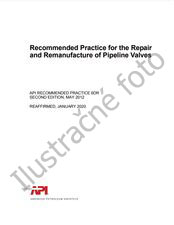Potrebujeme váš súhlas na využitie jednotlivých dát, aby sa vám okrem iného mohli ukazovať informácie týkajúce sa vašich záujmov. Súhlas udelíte kliknutím na tlačidlo „OK“.

API RP 970-ed.2
Corrosion Control Document Systems
NORMA vydaná dňa 1.4.2023
| Dostupnosť | Vypredané |
| Cena | NAOTÁZKU bez DPH |
| NA OTÁZKU |
Informácie o norme:
Označenie normy: API RP 970-ed.2
Dátum vydania normy: 1.4.2023
Kód tovaru: NS-1143448
Počet strán: 61
Približná hmotnosť: 183 g (0.40 libier)
Krajina: Americká technická norma
*) Pri tovare, ktorý nie je na sklade a musí sa objednávať u vydavateľa sa budú počítať aj skutočné náklady na dopravné a balné. Ich výšku Vám oznámime na základe vášho odkazu na e-mail info@normservis.sk, resp. na telefónnom čísle + 420 566 621 759.
Anotácia textu normy API RP 970-ed.2 :
API RP 970, 2nd Edition, April 2023 - Corrosion Control Document Systems
This recommended practice (RP) provides users with the basic elements for developing, implementing, and maintaining a Corrosion Control Document (CCD) for refining, and at the owner’s discretion, may be applied at petrochemical and chemical process facilities.
A CCD is a document or other repository or system that contains all the necessary information required to understand materials damage susceptibility issues in a specific type of operating process unit at a plant site. CCDs are a valuable addition to an effective Mechanical Integrity Program. They help to identify the damage mechanism susceptibilities of pressure-containing piping and equipment, factors that influence damage mechanism susceptibilities, and recommended actions to mitigate the risk of loss of containment or unplanned outages.
This RP serves as the basis for CCD development, implementation, and maintenance to maintain consistency and to integrate the CCD work process with other plant integrity programs, such as Management of Change (MOC), Process Hazards Analysis (PHA), and Reliability Centered Maintenance (RCM). Some of these programs have significant overlap with the development of CCDs, including Risk-based Inspection studies (see API Recommended Practice 580 and API Recommended Practice 581), Integrity Operating Windows (see API Recommended Practice 584), in-house unit corrosion reviews, circuitization/systemization programs, and similar types of corrosion studies. Development of CCDs can serve as a useful starting point for establishing these programs if they have not been undertaken.
This document provides the owner-operator with information and guidance on the work processes for development and implementation of CCDs for the owner-operator process units. While some generic examples are provided in the text and in 5.9, this document does not contain a complete list of unit-specific CCDs or operating plant variables for the numerous types of hydrocarbon processing units in the industry.
The rigor of review, the level of documentation, and even the need to develop a CCD will depend on the complexity of the process unit under consideration and the inherent risk associated with the process. It is the responsibility of the facility owner-operator to determine the level of detail contained within their CCD.
The scope of this standard includes:
- — descriptions of CCDs and definitions of related terminology;
- — creating, establishing, and maintaining CCDs;
- — data and information typically needed to create CCDs;
- — descriptions of the various types of CCDs needed for process units;
- — documenting and implementing CCDs;
- — reviewing, changing, and updating CCDs;
- — integrating CCDs with other risk management practices;
- — roles and responsibilities in the CCD work process; and
- — knowledge transfer to all stakeholders.
Typical CCDs cover the pressure-containing components of fixed equipment. The types of equipment and associated components typically covered by CCDs are:
- — pressure vessels,
- — process piping,
- — storage tanks atmospheric and pressurized,
- — process heaters pressurized components, and
- — heat exchangers.
The following equipment is not typically covered by CCDs, but may be at the user’s option:
- — instrument and control systems,
- — pressure relief devices,
- — pressure vessel internals,
- — machinery components,
- — pump casings and valve bodies,
- — stacks/flues,
- — electrical systems, and
- — structural systems.
However, these systems and components may be covered by other types of Risk-based Inspection (RBI) or risk assessment work processes, such as RCM.
This RP outlines the essential elements in defining, monitoring, and maintaining CCDs as a vital component of corrosion management (damage mechanism control strategies) and inspection planning, including RBI.
This RP does not address process operating windows established for normal process control, for the purposes of maintaining product quality, or for other operating factors unrelated to control for the purpose of maintaining equipment integrity and reliability. However, the contents of a comprehensive, good quality CCD can be the basis for establishing Integrity Operating Windows (IOWs) in accordance with API Recommended Practice 584.
This RP is a guideline document for organizing Corrosion Control Documents. The owner-operator of this RP may also develop internal documents that detail how their company will create and implement the processes suggested herein. Section 5 contains key points for establishing a site procedure that documents the CCD work process.
NOTE Even though CCDs are labeled “Documents” for the purposes of this RP, it is recognized that much of the suggested content of a CCD may, in fact, reside in separate repository systems. These separate repository systems are considered suitable alternatives to creating a separate or standalone CCD. It is not the intention of this RP to require operators to create a new document, but instead to have the components discussed in this document available for use in a work process covering integrity management.



 Cookies
Cookies
